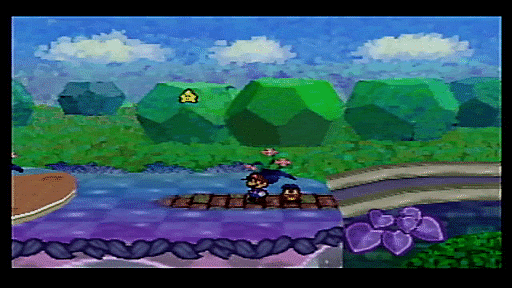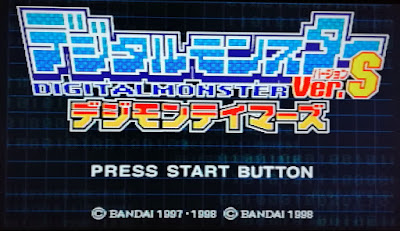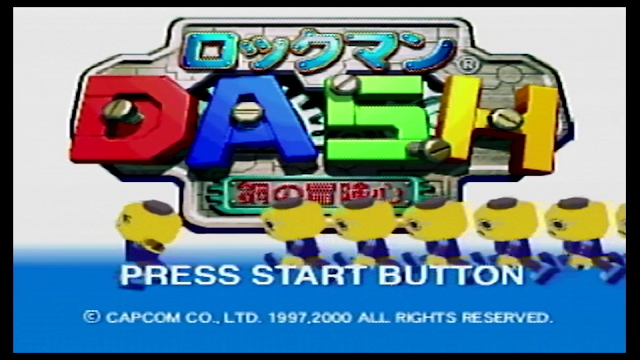Backlog Game Reviews 36: Paper Mario (N64)
Today let’s continue the retro game marathon with Paper Mario on the N64. It came out in Japan on August 11th, 2000. On February 5th, 2001, it made its way to North America. Europeans would have to wait until October 5th to get their hands on the game. It was originally going to be a sequel to Super Mario RPG on the SNES and was even called Super Mario RPG 2 when it started development. But as the project went on this name was dropped and in Japan, it was given the title Mario Story, while in other countries it was called Paper Mario.
 |
| A scene from the opening demo. |
It received heavy praise from reviewers for being a very beginner-friendly RPG. It sold extremely well and was the best-selling video game in Japan during its release week. Paper Mario was very popular back when it was new and maintains that popularity to this day. Let's see if it lives up to the hype.
 |
| The opening cutscene. |
High in the sky, way above the clouds is a place called the Star Sanctuary. It's here that the seven Star Spirits watch over a powerful treasure called the Star Rod. The Star Spirits use the Star Rod's power to grant the wishes of everyone around the world. Until one day Bowser infiltrated the Star Sanctuary and stole the Star Rod.
 |
| Bowser stealing the Star Rod. |
Sometime after Bowser stole the Star Rod Princess Peach threw a party at her castle. She invited people from many different towns from all around the Mushroom World and of course, sent an invitation to Mario and Luigi.
 |
| Luigi reading the party invitation to Mario. |
The brothers arrive at the party, and while Luigi is mingling with the other guests, Mario goes off to spend some time with Peach. Everyone is having a good time, but the festivities are cut short when a large earthquake shakes the castle. Soon after, Bowser makes his entrance and reveals that he caused the earthquake, using his castle, Bowser lifted Peach's castle into the sky.
 |
| Bowser's castle lifting Peach's castle into the sky. |
He then attempts to kidnap Peach, but Mario gets in his way and a battle ensues. Mario gains the upper hand, but Bowser turns the tables with the power of the Star Rod. Using it Bowser makes himself invincible and finally defeats Mario.
 |
| Bowser using the Star Rod against Mario. |
Overjoyed, Bowser takes some time to savor his victory before ejecting Mario out of the castle. After falling to the ground Mario is left unconscious, but when he wakes up, he is contacted by the Seven Star Spirits. They tell Mario that they've been captured by Bowser and are being held captive at separate locations by Bowser's top soldiers.
 |
| Mario gets thrown out of Peach's castle. |
If Mario can free all the Star Spirits, they can combine their powers and override the star rod, taking away Bowser's invincibility. This being Mario’s only hope of defeating Bowser and saving the princess, he sets off on an adventure that’ll take him across the Mushroom World.
 |
| Mario talking with the Star Spirits. |
This being an RPG the story is better than most Mario games. Sadly though, it's not that much better. While there's more meat to the story than most Mario games, at its core it's another Bowser kidnaps the princess and Mario has to save her story and doesn't evolve past that.
 |
| The games story is split into chapters, and in between chapters the story will focus on Peach. You'll even get to play as her for these parts. |
The Star Spirits say that if Bowser decided to use the star rod beyond powering himself up the world would be in serious trouble. But something like that never happens, the plot never advances in any way and kind of stops while Mario is saving the Star Spirits.
 |
| Mario talking to Twink, a star kid that helps both Mario and Peach throughout the adventure. |
Paper Mario's story is basic, but it's full of colorful characters with a lot of personality. Mario's partners all have distinct personalities and reasons for traveling with him. NPCs all have interesting dialogue that makes you want to see what they have to say, they also say different things as the story progresses, so you'll want to check up on them frequently. All of this makes the Mushroom World feel alive and makes up for the bare bones story.
 |
| Walking around Toad Town. It acts as your central hub that's connected to all the towns in the game. |
Moving on to the gameplay, it's a turn-based RPG that as past reviewers have said is very beginner-friendly. Battles aren't random, enemies can be seen walking around, and running into one will initiate a battle. You can get a preemptive strike by jumping on an enemy or hitting them with your hammer on the overworld map, but you can also get attacked on the overworld map, so you need to be careful.
 |
| Landing a preemptive strike. |
The flow of battle is pretty simple, Mario and his partner get to attack first, and then it's the enemy's turn. Mario has two main attacks, jumping and his hammer. Jumping can hit ground and air foes but isn't effective if the opponent is protected by spikes or has high defense. That's where the hammer comes in, it can safely damage spiked enemies and can hurt armored foes.
 |
| Battle against the Goomba King. |
In addition to these two attacks, Mario can also perform special attacks if he has badges equipped. Badges are items that when equipped grant Mario a special ability, attack, or raise his stats. There are a lot of badges in this game. They range from passive abilities such as raising your attack, HP, and defense. There's one that gives you coins when you use an item in battle, and one that lets you use 3 items in one turn.
 |
| Equipping a badge. |
Others give you access to new attacks such as a powered-up hammer or jump attack, or my favorite, a badge that lets you create an earthquake with your hammer, damaging all enemies on the ground.
 |
| A powered up jump attack. |
There are so many different badges that do different things, making Mario a very versatile character. I mainly equipped badges that buff your stats, but there's so much more you can do. Badges make Mario highly customizable, which gives the game good replay value. Badges also add a layer of strategy to the gameplay, being smart about what badges to equip can make a difficult boss very, very easy. So, while the core gameplay is very simple, badges give it some complexity.
 |
| Leveling up. When you level up you get to pick what stat to increase. HP, FP, this games version of MP, or BP, in order to equip badges you need BP. |
There's very little to complain about when it comes to Paper Mario's battle system. It's simple enough to where anybody can pick up the controller and understand what to do, but thanks to the badges there is a good amount of strategy involved.
 |
| Saving a Star Spirit. |
And then there are the action commands. When attacking, successfully doing the on-screen action command will result in you doing double damage. And when getting attacked, pressing the A button at the right time will reduce the damage you take by one point, making for some engaging battles. This and everything else combined create a battle system that is very enjoyable and never gets old.
 |
| The action command for attacking with the hammer is one of the easiest in the game. All you have to do is hold the control stick to the left until the gauge fills up. |
So, the battle system is great, which is a good thing as battling is a large chunk of the game. Outside of battling there isn't much to do. The game is pretty linear and doesn't have any branching paths or hidden areas, so there isn't much in the way of exploration. There are a few mini-games you can play, but they aren't that great. And besides a few optional bosses, there's only one side-quest.
 |
| Mario's partners all have a special ability that can be used on the over-world map. |
The lack of side-quests is a bit disappointing, but the main story makes up for it. The quest to save the Star Spirits will take you all over the Mushroom World. Some locations are a little dull, such as the desert and jungle area. But other areas like Flower Land or Shy Guy's Toy Box are unique and interesting locations.
 |
| Shy Guy's Toy Box is one of the most unique locations in the game. |
With all that said, Paper Mario on the N64 is a game I can easily recommend to just about anybody. The badges offer enough complexity to draw in RPG fans but is also simple enough for non-RPG fans to get into. And the action commands make this game way more interactive than most RPGs of the time. So, people that aren't all that into RPGs can also have a good time. Paper Mario has a little something for everyone, as long as you don't just straight out hate RPGs then I would say this game is worth giving a try.
 | |
| The world map |
The graphics hold up very well. The characters all look like paper cutouts hence the name Paper Mario, this is sometimes played up for laughs, like when Mario falls from a high height he gently floats down. Other than that, the paper art style is just that, an art style. It doesn’t affect the gameplay in any way. Everything else is in 3D, it makes the world look like a popup book. This unique art direction gives the game a timeless look. No matter how old the game gets the graphics never look old or outdated.
 |
| You'll find star pieces throughout the game. These can be used to buy one of a kind badges. |
There's nothing to complain about when it comes to the music. It's all really good, some songs aren't all that memorable, but serve their purpose as background music well. Other songs like the title theme can easily get stuck in your head for days on end.
 |
| Mario vs The Koopa Bros. Boss battles have some of the best musical themes in the game. |
That's all I have to say about Paper Mario on the N64. On the surface, it's a basic RPG, but once you start to sink your teeth into it, it shows a level of complexity that RPG fans and non-RPG fans alike can enjoy.
Thanks
for reading! The retro game marathon marches on as we take a look at a Famicom
game next time. I hope to see you again here at Backlog Game Reviews.




Comments
Post a Comment